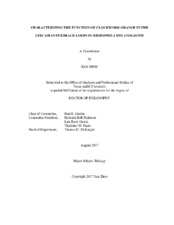| dc.description.abstract | The Drosophila circadian oscillator controls daily rhythms in physiology, metabolism and behavior via transcriptional feedback loops. CLOCK-CYCLE (CLK-CYC) heterodimers initiate feedback loop function by binding enhancer box (E-box) elements to activate period (per) and timeless (tim) transcription. PER-TIM heterodimers then accumulate, bind CLK-CYC to inhibit transcription, and are ultimately degraded to enable the next round of transcription. Although tremendous efforts have been made to understand how these feedback loops are regulated, the detailed molecular mechanism of transcriptional repression is still not clear. By using genetic, molecular, and genome-wide bioinformatic analyses, I have characterized the molecular function of the transcription factor CLOCKWORK ORANGE (CWO) for the circadian transcriptional repression, and further identified its downstream targets aiming to understand its function at genome-wide level.
The timing of transcriptional events in the circadian feedback loops coincide with, and are controlled by, rhythms in CLK-CYC binding to E-boxes. PER rhythmically binds CLK-CYC to initiate transcriptional repression, and subsequently promotes the removal of CLK-CYC from E-boxes. However, little is known about the mechanism by which CLK-CYC are removed from DNA. Here I show that the transcription repressor CWO rhythmically binds E-boxes upstream of core clock genes in a reciprocal manner to CLK, thereby promoting PER-dependent removal of CLK-CYC from E-boxes, and maintaining repression until PER is degraded and CLK-CYC displaces CWO from E-boxes to initiate transcription. These results suggest a model in which CWO co-represses CLK-CYC transcriptional activity in conjunction with PER by competing for E-box binding once CLK-CYC-PER complexes have formed. Given that CWO orthologs DEC1 and DEC2 also target E-boxes bound by CLOCK-BMAL1, a similar mechanism may operate in the mammalian clock. Furthermore, using ChIP-seq and RNA-seq analyses, I show that CWO directly and indirectly regulates gene expression at genome-wide level. A substantial overlap between CWO and CLK direct target genes suggests that CWO plays a potential role in regulating CLK-mediated transcription globally. Moreover, CWO indirectly regulates a subset of genes encoding kinases and phosphatases at transcriptional level, suggesting its role in the posttranscriptional regulation of CLK during the circadian cycle. | en |


